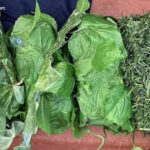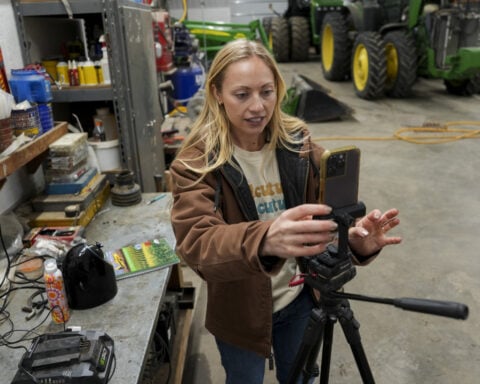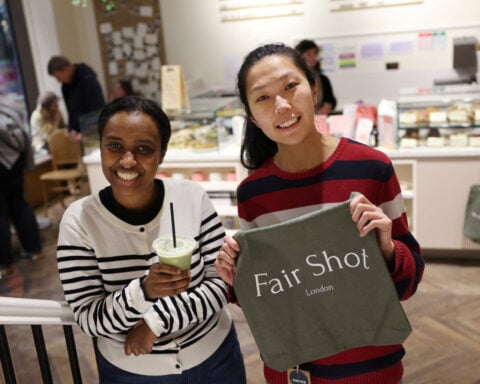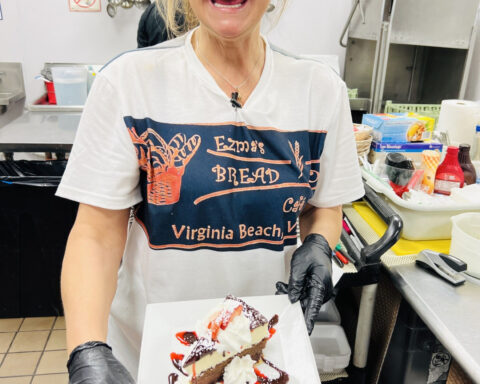(CNN) — When Hannah was 7 years old, she told her parents she didn’t want to be afraid of food anymore.
She had stopped wanting to go to Girl Scouts, birthday parties, restaurants, family celebrations and even the dinner table. Food was everywhere, and it gave her a lot of anxiety, said her mom, Michelle, who is not sharing their last name for Hannah’s safety.
Michelle first saw it when she tried to switch baby Hannah from formula to milk and solids— but Hannah refused. Often, she would pucker her lips shut or spit out the food she was given.
As she got older, Hannah had a list of about five foods she would eat, and they were specific. Like the green sour cream and onion Pringles, but only the small packs, not the big container, Michelle said.

Now 8 years old, Hannah is being treated for Avoidant/Restrictive Food Intake Disorder, or ARFID. Unlike eating disorders like anorexia or bulimia nervosa, this diagnosis isn’t concerned with body shape or size, said Kate Dansie, clinical director of the Eating Disorder Center in Rockville, Maryland.
Instead, people with ARFID are very limited in the foods they feel safe and comfortable eating, Dansie said. Unlike just being “picky,” this disorder can be debilitating and cause long-term health problems.
The diagnosis is new and was only added to the fifth edition of the Diagnostic and Statistical Manual of Mental Disorders, DSM-5, in 2013. (The DSM is the handbook health care professionals use as the authoritative guide in diagnosing mental disorders.)
While an estimated 9% of the US population will have an eating disorder at some point, studies suggest that somewhere between 0.5% and 5% of the population has ARFID, according to the National Eating Disorders Association.
“I would call this the silent eating disorder because it’s very prevalent, but it’s the least studied, and it’s the least talked about, and it’s the least funded at a federal research level,” said Dr. Stuart Murray, associate professor of psychiatry and behavioral sciences at the University of Southern California and director of the Translational Research in Eating Disorders Laboratory.
Here is what experts want you to know about ARFID.
What is ARFID?
Rather than restricting their calories or nutritional content, people with ARFID often limit their food by sensory or textural preferences, Murray said.
“This is where a person will usually restrict the variety and volume of food because they have incredibly debilitating beliefs about the composition of the food,” he added. “Examples can be not eating any foods that are a certain texture, a certain smell, a certain flavor, even a certain brand of a food.”
In some cases, people with ARFID have had a traumatic experience with food, like choking, which induces a greater vigilance with eating, Murray said. Other times, people with this condition don’t seem to have a low drive to eat and high anxiety around food, he said.
A rigid or fearful of change personality type may also contribute to ARFID symptoms, Murray said.
Is it like picky eating?
Many kids are picky and try to get out of eating some vegetables or other food, but that is not the same as ARFID, Dansie said.
One way to spot the difference is the level of impairment and anxiety that comes with facing a new food, Murray said.
“A picky eater might be able to eat around a certain food on their plate, or they might be able to have a little bit of it,” he said. “Somebody with ARFID might not be able to eat anything on the plate if a food that’s deemed to be unacceptable is on the plate.”
And it isn’t just a handful of foods that people with ARFID won’t eat, Dansie said. Often, people with this condition will have a list of as few as five or 10 foods that they feel comfortable eating, she added.
A greater vigilance around tasting may also come with ARFID, and many people with the condition can tell small differences, like if the brand of pasta sauce has been changed, Murray added.
“That in itself can be quite debilitating and crippling for parents,” he said.
A good relationship with food is fundamental
The condition often starts in childhood, but ARFID can impact people of all ages, Murray said. And people can experience consequences throughout their life.
“Kids can really fall off their growth curve quite quickly,” he said. “They can become metabolically, nutritively imbalanced very quickly, so the medical effects are quite profound.”
Hannah experienced this before she began working with an ARFID specialist. She had been keeping pace with the expected growth and weight gain for her age. But with not enough food in her system, her growth stopped, Michelle said.
In some cases, the restriction around eating can lead to weight loss or hospitalization, Murray said.
“With any kind of psychological or psychiatric issue, the (indicator of a problem) is always when it’s affecting the child and the family,” Dansie said. “When the impact is significant, that that’s when we get worried.”
There can be social impacts as well.
“This can be very isolating people,” Murray said. “Kids become super anxious about going to parties or any type of social event where they think they might not know what the food is going to be.”
Often, issues around food and eating impact many areas of a person’s life, Dansie said.
“What I’ve found is that if you can look at a person’s relationship with food, you can look at their relationship with everything,” she said. “It’s so fundamental to well-being to have a good relationship with food.”
ARFID isn’t something kids just grow out of, so it is important to approach it with as much sympathy and compassion as possible, he added.
What you can do
Although there is much researchers still need to learn about ARFID, there are resources available, Murray said.
“The first thing we should know is early intervention is better because the list of avoided foods can grow exponentially,” he said.
There isn’t much data on if medication is helpful, but therapy – including cognitive behavioral therapy or CBT – has helped many people.
Therapy for ARFID “usually involves a guided exposure to foods so that one can relearn associations with those foods and ultimately not avoid them,” Murray said.
At home, there are things families can do to better support a child with ARFID, like prioritizing making sure the child gets enough calories before focusing on expanding variety, said Dr. Nicole Stettler, clinical executive director of Eating Disorder Recovery Services at Rogers Behavioral Health.
You can also give your child tools like timers or visual reminders to eat, and try “food chaining,” which is a strategy that combines new foods with ones they already know they like, she said.
As family and caretakers of someone with ARFID, it is important to remember that they aren’t trying to be difficult – although it can be frustrating to feel like the stars have to align for a mealtime to go smoothly, Murray added.
“It’s really, really frustrating, because most of the time the stars don’t align, and I don’t know the formula to get him or her to eat,” he said. However, it is “really damaging for any child with any psychiatric disorder if they feel punished because of it, so it’s really important to not punish and adopt a supportive stance among parents.”
Five months into her treatment, Hannah pushing herself to try new things often and to take three bites to give it a full chance, Michelle said.
Her confidence has grown, she is getting more curious, and her list of “safe foods” has increased by 11, she said.
“Our goal is to get her to a good place … so that as she gets older, she’ll have the tools that she needs,” Michelle said.
The-CNN-Wire
™ & © 2024 Cable News Network, Inc., a Warner Bros. Discovery Company. All rights reserved.

 Former Florida art museum director involved in Basquiat forged painting probe has died
Former Florida art museum director involved in Basquiat forged painting probe has died
 Raiders hire Bucs assistant general manager John Spytek as their GM, AP source says
Raiders hire Bucs assistant general manager John Spytek as their GM, AP source says
 Samsung aims to turn its next generation of Galaxy smartphones into AI companions
Samsung aims to turn its next generation of Galaxy smartphones into AI companions
 Yemen’s Houthis free crew of Red Sea cargo ship after 14 months in captivity
Yemen’s Houthis free crew of Red Sea cargo ship after 14 months in captivity
 TikTok’s parent company is in active discussions about a deal, board member says
TikTok’s parent company is in active discussions about a deal, board member says
 As Wemby Week continues in Paris, the Spurs star is handling it all with apparent ease
As Wemby Week continues in Paris, the Spurs star is handling it all with apparent ease
 International theft ring targeting Asian business owners in several cities: police
International theft ring targeting Asian business owners in several cities: police
 Winter storm causes rescheduling of NBA and college games across the South
Winter storm causes rescheduling of NBA and college games across the South
 Lions defensive coordinator Aaron Glenn agrees to terms with Jets to be head coach, AP source says
Lions defensive coordinator Aaron Glenn agrees to terms with Jets to be head coach, AP source says








